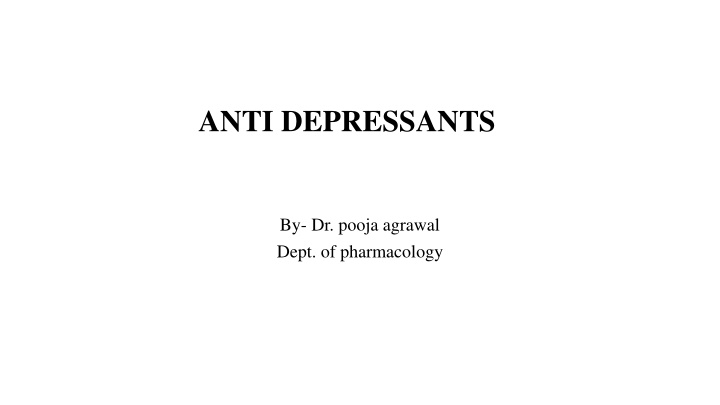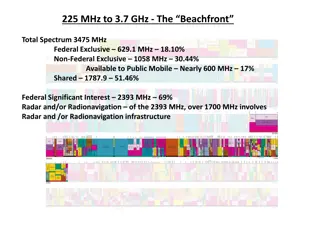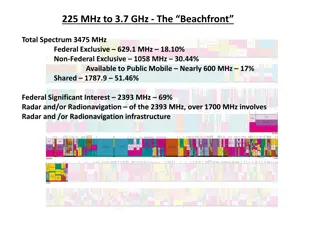
Antidepressants: Mechanisms, Types, and Effects
Explore the classification, mechanisms, side effects, and uses of antidepressants including SSRIs, TCAs, and SNRIs. Learn about the neurotrophic and monoaminergic hypotheses of depression.
Download Presentation

Please find below an Image/Link to download the presentation.
The content on the website is provided AS IS for your information and personal use only. It may not be sold, licensed, or shared on other websites without obtaining consent from the author. If you encounter any issues during the download, it is possible that the publisher has removed the file from their server.
You are allowed to download the files provided on this website for personal or commercial use, subject to the condition that they are used lawfully. All files are the property of their respective owners.
The content on the website is provided AS IS for your information and personal use only. It may not be sold, licensed, or shared on other websites without obtaining consent from the author.
E N D
Presentation Transcript
ANTI DEPRESSANTS By- Dr. pooja agrawal Dept. of pharmacology
COMPETENCY PH 1.19 Describe the mechanism/s of action, types, doses, side effects, indications and contraindications of antidepressants.
OBJECTIVES 1. Classify antidepressants 2. Describe pharmacokinetics, mechanism of action, uses and adverse effects of tricyclic antidepressants(TCA). 3. Describe pharmacokinetics, mechanism of action, uses and adverse effects of selective serotonin reuptake inhibitors(SSRI). 4. Describe pharmacokinetics, mechanism of action, uses and adverse effects of Serotonin and non-adrenaline reuptake inhibitors(SNRI) 5. Enlist reversible inhibitors of MAO-A and describe their clinical status and interactions 6. Enumerate various atypical antidepressants and describe their clinical status and advantages over TCAs 7. Enumerate other uses of antidepressants drugs
INTRODUCTION Major depression and mania are two extremes of affective disorders refer to a pathological change in mood state. Major depression sad mood loss of interest and pleasure low energy, worthlessness, guilt psychomotor retardation or agitation change in appetite and/or sleep, melancholia, suicidal thoughts Anxiety and depression are the leading psychiatric disorders
1256716361Depression 24302748b35da0429ab4b1da2b0d-grande depression depression depressed_boy S03E03
NEUROTROPHIC HYPOTHESIS OF DEPRESSION hypothesis -depression is associated with deficiency of brain derived neurotrophic factor (BDNF) and other nerve growth factors (NGFs) in brain areas regulating feelings, emotion, cognition, hedonia, behaviour, etc. Antidepressants promote elaboration of NGFs. NGFs activate receptor tyrosine kinases (RTKs) and enhance axonal/dendritic growth, promote synaptic connection and improve neural plasticity. Reduction of BDNF levels and neural mass in the limbic areas has been demonstrated in depression Prolonged antidepressant treatment has been found to elevate BDNF levels as well as enhance neurogenesis and synaptic connections.
MONOAMINERGIC HYPOTHESIS OF DEPRESSION Hypothesis -depression is caused by deficient noradrenergic and/or serotonergic transmission in the brain (mainly in cortical and limbic areas). All classes of antidepressants (TCAs, SNRIs, SSRIs, atypical) enhance synaptic availability of NA or 5-HT or both, in one way or the other.
MAO INHIBITORS Two isoenzyme forms of MAO have been identified. MAO-A: Preferentially deaminates 5-HT and NA, and is inhibited by Clorgyline, Moclobemide. MAO-B: Preferentially deaminates phenylethylamine and is inhibited by Selegiline. Dopamine is equally degraded by both isoenzymes. Distribution MAO-A - Peripheral adrenergic nerve endings, intestinal mucosa and human placenta MAO-B- predominates (mainly serotonergic) of brain and in platelets. Liver contains both isoenzymes.
NONSELECTIVE MAO INHIBITORS Nonselective MAO inhibitors elevate the mood of depressed patients; in some cases it may progress to hypomania and mania. Active metabolites of nonselective MAO inhibitors inactivate the enzyme irreversibly. Drugs themselves stay in the body for relatively short periods, but their effects last for 2 3 weeks after discontinuation: they are hit and run drugs.
Selective MAO-A inhibitors possess antidepressant property. Selegiline selectively inhibits MAO-B at lower doses (5 10 mg/day), but these are not effective in depression. metabolized to amphetamine and at higher doses it becomes nonselective MAO inhibitor exhibits antidepressant and excitant properties.
INTERACTIONS (i) Cheese reaction Certain varieties of cheese, beer, wines, pickled meat and fish, yeast extract contain large quantities of tyramine, dopa, etc. MAO inhibited patients these indirectly acting sympathomimetic amines escape degradation in the intestinal wall and liver reaching into systemic circulation they displace and release large amounts of NA from transmitter loaded adrenergic nerve endings hypertensive crisis, cerebrovascular accidents. TREATED: i.v. injection of a rapidly acting blocker, e.g. phentolamine. Prazosin or chlorpromazine are alternatives
ii) Cold and cough remedies contain ephedrine or other sympathomimetics hypertensive reaction can occur (iii) Reserpine, guanethidine, tricyclic antidepressants Excitement, rise in BP and body temperature can occur when these drugs are given to a patient on MAO inhibitors. This is due to their initial NA releasing or uptake blocking action. (iv) Levodopa Excitement and hypertension occur due to increase in biological t of DA and NA that are produced from levodopa.
v) Antiparkinsonian anticholinergics Hallucinations and symptoms similar to those of atropine poisoning occur. (vi) Barbiturates, alcohol, opioids, antihistamines Action of these drugs is intensified and prolonged. Respiration may fail. (vii) Pethidine High fever, sweating, excitation, delirium, convulsions and severe respiratory depression have occurred. MAO inhibitors retard hydrolysis of pethidine but not its demethylation. Excess of norpethidine (normally a minor metabolite is produced which has excitatory actions)
REVERSIBLE INHIBITORS OF MAO-A (RIMAS) MOCLOBEMIDE Reversible and Selective MAO-A inhibitor with short duration of action; full MAO activity is restored within 1 2 days of stopping the drug. Because of competitive enzyme inhibition, tyramine is able to displace it from the enzyme, so that potentiation of pressor response to ingested amines is minor, and dietary restrictions are not required. lacks the anticholinergic, sedative, cognitive, psychomotor and cardiovascular adverse effects of typical TCAs and is safer in overdose. good option in elderly patients and in those with heart disease.
ADVERSE EFFECTS nausea, dizziness, headache, insomnia, rarely excitement and liver damage. Chances of interaction with other drugs and alcohol are remote, but caution is advised while co-prescribing pethidine, SSRIs and TCAs. Moclobemide -alternative to TCAs for mild to moderate depression and for social phobia.
TRICYCLIC ANTIDEPRESSANTS (TCAs) IMIPRAMINE inhibited NA and 5-HT reuptake into neurons. first generation antidepressants-uptake blockade and direct effects on adrenergic, cholinergic and histaminergic receptors and also includes MAOIs. Second generation antidepressants -Selective serotonin reuptake inhibitors (SSRIs), or Serotonin and noradrenaline reuptake inhibitors (SNRIs), with no direct action on cholinergic/adrenergic/histaminergic receptors, or have some atypical features.
PHARMACOLOGICAL ACTIONS MOA- inhibit norepinephrine transporter (NET) and serotonin transporter (SERT) interact with a variety of receptors viz. muscarinic, adrenergic, histamine H1, 5- HT1, 5-HT2 and occasionally dopamine D2. Actions of imipramine are described as prototype
REM sleep- phase is suppressed and awakenings during night are reduced. Sedative ones are suitable for depressed patients showing anxiety and agitation. TCAs lower seizure threshold and produce convulsions in overdose. Clomipramine and bupropion highest seizure precipitating potential. Amitriptyline and imipramine depress respiration in overdose only. Inhibition of NA and 5-HT uptake is associated with antidepressant action. Inhibition of DA uptake correlates with stimulant action.
MECHANISM OF ACTION MOA: inhibit NET and SERT which mediate active reuptake of biogenic amines NA and 5- HT into their respective neurons and thus potentiate them. DA uptake-inhibited by bupropion. TCAs indirectly facilitate dopaminergic transmission in forebrain that may add to the mood elevating action. Tentative conclusions drawn are: and start taking interest in self and surroundings.
1.CNS Effects differ in normal individuals and in the depressed. In normal individuals- peculiar clumsy feeling, tiredness, light-headedness, sleepiness, difficulty in concentrating and thinking, unsteady gait. effects tend to provoke anxiety. no mood elevation or euphoria; effects are rather unpleasant and may become more so on repeated administration. Depressed patients Little acute effects are produced, except sedation (in the case of drugs which have sedative property). After 2 3 weeks of continuous treatment, the mood is gradually elevated, patients become more communicative
2.ANS 2.ANS TCAs are potent anticholinergics cause dry mouth, blurring of vision, constipation and urinary hesitancy as side effect. anticholinergic potency is graded TCAs potentiate exogenous an endogenous NA by blocking uptake, but also have weak 1 adrenergic blocking action. Some, e.g. amitriptyline, doxepin, trimipramine have slight H1 antihistaminic action as well.
3.CVS Tachycardia: due to anticholinergic and NA potentiating actions. Postural hypotension: due to inhibition of cardiovascular reflexes and 1 blockade. ECG changes and cardiac arrhythmias: T wave suppression or inversion is the most consistent change in ECG. Arrhythmias occur in overdose NA potentiating + cholinergic blocking actions along with direct myocardial depression compound the proarrhythmic potential. SSRIs, SNRIs and atypical antidepressants are safer in this regard.
TOLERANCE AND DEPENDENCE TOLERANCE AND DEPENDENCE Tolerance to the anticholinergic and hypotensive effects of imipramine-like drugs develops gradually, but antidepressant action is sustained. Addiction to these drugs is rare, because their acute effects are not pleasant. There is some evidence of physical dependence occurring when high doses are used for long periods malaise, chills, muscle pain may occur on discontinuation and have been considered withdrawal phenomena. Gradual withdrawal is recommended, but antidepressants do not carry abuse potential.
PHARMACOKINETICS oral absorption of TCAs is good, though often slow. highly bound to plasma and tissue proteins, therefore have large volumes of distribution (~20 L/kg). metabolized in liver Inactivation occurs by oxidation and glucuronide conjugation. Various CYP isoenzymes like CYP2D6, CYP3A4, CYP1A2 and others metabolize tricylic and related antidepressants. Metabolites are excreted in urine over 1 2 weeks.
plasma t of amitriptyline, imipramine and doxepin range between 1624 hours. t is longer for some of their active metabolites. Because of relatively long t s, once daily dosing (at bedtime) is practicable in the maintenance phase. therapeutic window phenomenon has been observed, i.e. optimal antidepressant effect is exerted at a narrow band of plasma concentrations (between 50 200 ng/ml of imipramine, amitriptyline, nortriptyline). doses need to be individualized and titrated with the response
ADVERSE EFFECTS 1. ANTICHOLINERGIC: dry mouth, bad taste, constipation, epigastric distress, urinary retention (especially in males with enlarged prostate), blurred vision, palpitation. 2. Sedation, mental confusion and weakness especially with amitriptyline and more sedative congeners. 3.Increased appetite and weight gain -TCAs and trazodone 4. Sweating (despite antimuscarinic action) and fine tremors are relatively common
6.Seizure threshold is loweredBupropion, clomipramine, Amoxapine 7. Postural hypotension, especially in older patients. Less severe with desipramine-like drugs and insignificant with SSRIs/SNRIs. 8. Sexual distress 9. Cardiac arrhythmias, especially in patients with ischaemic heart disease. Arrhythmias may be responsible for sudden death in these patients. 10. Rashes and jaundice due to hypersensitivity are rare. Mianserin is more hepatotoxic.
ACUTE POISONING Poisoning with TCAs is frequent; usually self-attempted for suicide, and may endanger life. Manifestations are: Excitement, delirium and other anticholinergic symptoms as seen in atropine poisoning, followed by muscle spasms, convulsions and coma. Respiration is depressed, body temperature may fall, BP is low, tachycardia is prominent. ECG changes and ventricular arrhythmias are common.
Treatment is primarily supportive with gastric lavage, respiratory assistance, fluid infusion, maintenance of BP and body temperature. Acidosis must be corrected by bicarbonate infusion. Diazepam -injected i.v. to control convulsions and delirium. The treatment of cardiac arrhythmias-propranolol/lidocaine class IA and IC antiarrhythmics and digoxin -depress cardiac conduction; are therefore contraindicated.
INTERACTIONS 1. TCAs potentiate directly acting sympathomimetic amines (present in cold/asthma remedies). Adrenaline containing local anaesthetic should be avoided 2.TCAs potentiate CNS depressants, including alcohol and antihistaminic. 3. Phenytoin, phenylbutazone, aspirin and CPZ can displace TCAs from protein binding sites and cause transient overdose symptoms. 4. Phenobarbitone competitively inhibits as well as induces imipramine metabolism. Carbamazepine and other enzyme inducers enhance metabolism of TCAs.
5.SSRIs inhibit metabolism of several drugs including TCAsdangerous toxicity can occur if the two are given concurrently. 6.Anticholinergic property- TCAs delay gastric emptying and retard their own as well as other drug s absorption. 7. MAO inhibitors dangerous hypertensive crisis with excitement and hallucinations has occurred when given with TCAs.
SELECTIVE SEROTONIN REUPTAKE INHIBITORS (SSRIs) relative safety and better acceptability of SSRIs has made them 1st line drugs in depression and allowed their extensive use in anxiety, phobias, panic, OCD and related disorders. SSRIs produce little or no sedation, do not interfere with cognitive and psychomotor function or produce anticholinergic side effects. devoid of adrenergic blocking action postural hypotension does not occur, making them suitable for elderly patients.
SIDE EFFECTS Gastrointestinal nausea (due to 5-HT3 receptor stimulation), Loose motions are due to 5-HT uptake blockade in the gut and activation of 5-HT receptors on enteric plexus neurones. Weight gain, but they more commonly interfere with ejaculation or orgasm. Nervousness, restlessness, insomnia, anorexia, dyskinesia and headache Epistaxis and ecchymosis, probably due to impairment of platelet function. Gastric blood loss due to NSAIDs may be increased by SSRIs.
INTERACTIONS Inhibit drug metabolizing isoenzymes CYP2D6 and CYP3A4: elevate plasma levels of TCAs, haloperidol, clozapine, warfarin, blockers, some BZDs and carbamazepine. Serotonin syndrome manifesting as agitation, restlessness, rigidity, hyperthermia, delirium, sweating, twitching's followed by convulsions can be precipitated when any serotonergic drug (e.g. MAOIs, tramadol, pethidine) is taken by a patient receiving SSRIs Discontinuation reaction-paresthesias, bodyache, bowel upset, agitation and sleep disturbances Because of freedom from psychomotor and cognitive impairment, SSRIs are preferred over TCAs for prophylaxis of recurrent depression (should be combined with lithium/valproate).
FLUOXETINE first SSRI and longest acting. plasma t is 2 days and that of its active demethylated metabolite is 7 10 days. approved for use in children 7 years or older for depression and OCD S/E: Agitation and dermatological reactions Slower onset of antidepressant effect, less suitable for patients needing rapid effect
FLUVOXAMINE a shorter-acting SSRI USE: generalized anxiety disorder (GAD) and OCD. S/E: nausea, dyspepsia, flatulence, nervousness and discontinuation reactions
PAROXETINE short acting SSRI (t 20 hours) which does not produce active metabolite. S/E: GIT side effects, sexual distress, agitation and discontinuation reaction Sedation and anti muscarinic effects are mild.
SERTRALINE USE: juvenile depression has been demonstrated, and it is recommended for anxiety and post-traumatic stress disorder (PTSD) as well. Drug interactions due to inhibition of CYP isoenzymes are less likely to occur with sertraline. plasma t is 26 hours
CITALOPRAM SSRI shares with sertraline a lower propensity to cause drug interactions. t is 33 hours Q-T prolongation and few deaths due to overdose of citalopram are on record, because of which it is to be avoided in patients likely to attempt suicide. USE: mood disorders in premenstrual dysphoric disorder (PMDD)
ESCITALOPRAM Active S(+) enantiomer of citalopram, effective at half the dose USE: anxio-depressive disorders. Relief from menopausal hot flashes has been obtained in women who cannot take estrogens. Side effects are milder and safety is improved.
DAPOXETINE SSRI is being promoted particularly for delaying premature ejaculation Dapoxetine acts rapidly and can be taken 1 hour before sexual intercourse. Combined with behavioural therapies SIDE EFFECTS : nausea, vomiting, loose motions, headache, dizziness and occasionally insomnia
OTHER USES OF SSRIS SSRIs are now 1st choice drugs for OCD, panic disorder, social phobia, eating disorders, PMDD, and PTSD. increasingly used for anxiety disorders, body dysmorphic disorder, compulsive buying, kleptomania and premature ejaculation. Elevation of mood and increased work capacity has been reported in postmyocardial infarction and other chronic somatic illness patients.
SEROTONIN and NORADRENALINE REUPTAKE INHIBITORS (SNRIs) Venlafaxine MOA: inhibits uptake of both NA and 5-HT in contrast to older TCAs, does not interact with cholinergic, adrenergic or histaminergic receptors or have sedative property. A faster onset of action USE: Mood changes and hot flashes in menopausal syndrome, social anxiety and eating disorders tends to raise rather than depress BP and is safer in overdose. SIDE EFFECTS : nausea, sweating, anxiety, dizziness, impotence and withdrawal reactions on discontinuation







